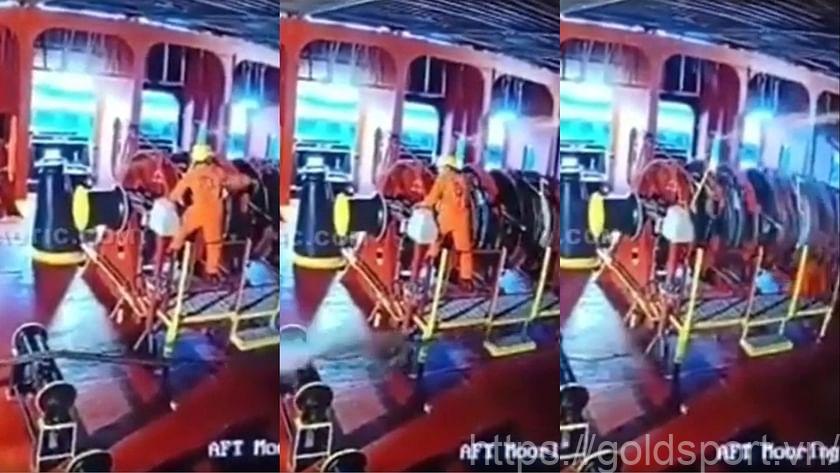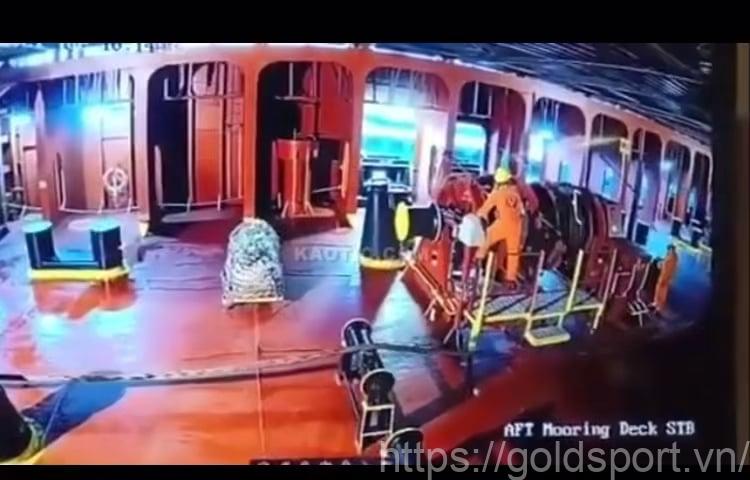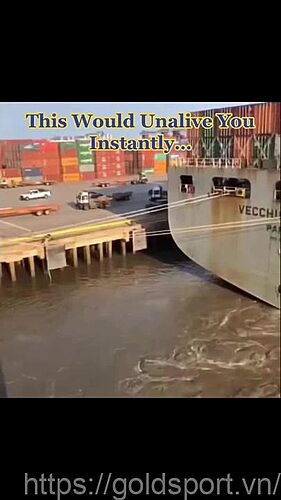Exploring the Deadly Power of Snapback Zones: Shocking Video of Mooring Line Accident

Discover the chilling reality of snapback zones video accident original showcasing a shocking mooring line accident. Witness the original footage that has traumatized viewers and shed light on the dangers of handling tensioned ropes. Learn how the snapback zone can extend up to 60 feet and the importance of proper training and safety procedures. Join the conversation sparked by this video on Goldsport and raise awareness about the deadly power of snapback zones. Stay informed and prevent snapback accidents with our comprehensive guide.

| Key Takeaways |
|---|
| Understanding the risks and precautions associated with snapback zones |
| Exploring the shocking mooring line accident captured in a viral video |
| How far does the danger of a snapback zone extend? |
| The importance of training and safety procedures when handling mooring lines |
| How the video raises awareness and sparks conversations about snapback hazards |
| Best practices for preventing snapback accidents |
The Danger of Snapback Zones: Understanding the Risks and Precautions
Understanding Snapback Zones
Snapback zones refer to the area surrounding a rope or line under tension where there is a significant risk of injury or even death if the line breaks or becomes disconnected. When a line snaps back, it releases an immense amount of stored energy, propelling it backward with tremendous force. These snapback zones can extend for several feet, depending on the tension in the line and its length. It is crucial to be aware of these zones and take appropriate precautions when working with mooring lines or any other ropes under tension.
The Risks Involved
The risks associated with snapback zones are severe and should not be underestimated. A sudden release of tension in a line can cause it to whip back violently, potentially striking anyone within the snapback zone. The force generated by a snapping line can cause serious injuries such as fractures, lacerations, or even traumatic brain injuries. In some cases, snapback accidents have resulted in fatalities. It is essential to recognize the potential dangers and take proactive measures to prevent such incidents from occurring.
Precautions to Minimize Snapback Hazards
To minimize the risks associated with snapback zones, it is crucial to follow proper safety procedures and implement necessary precautions. Some key precautions include wearing appropriate personal protective equipment (PPE), such as helmets and gloves, when working with lines under tension. Maintaining a safe distance from the snapback zone and ensuring that only trained personnel handle mooring lines are also essential steps in preventing accidents. Regular inspections of ropes and lines for signs of wear and tear, as well as proper training on handling procedures, are crucial to maintaining a safe working environment. By understanding the risks and taking appropriate precautions, we can mitigate the potential dangers posed by snapback zones and ensure the safety of those working with lines under tension.
An Unsettling Video Goes Viral: Exploring the Shocking Mooring Line Accident
The Gruesome Accident Captured on Video
The internet has been abuzz with a horrifying video that has gone viral, depicting a mooring line accident caused by the snapback zone. The footage shows the moment when a crew member is struck by a violently recoiling mooring line, catapulting them backward with immense force. The graphic nature of the video has sent shockwaves through the online community, leaving viewers traumatized by the devastating consequences of being caught in the snapback zone.
A Wake-Up Call for Boat Safety
The viral video serves as a stark reminder of the inherent dangers associated with snapback zones on boats. It highlights the need for increased awareness and adherence to safety protocols when handling mooring lines under tension. The sheer power and speed at which the line recoils, posing a serious threat to anyone in its vicinity, underscore the importance of proper training and precautions in maritime operations.
Impact and Awareness
The widespread circulation of this unsettling video has had a profound impact on viewers, sparking conversations about the risks involved in working near tensioned lines. Many individuals who have watched the footage have expressed their shock and disbelief at the potential lethality of such accidents. This increased awareness has prompted discussions among maritime professionals, industry experts, and safety organizations on how to prevent similar incidents and mitigate the risks associated with snapback zones.

Examining the Snapback Zone: How Far Does the Danger Extend?
Understanding the Snapback Zone
The snapback zone refers to the area of danger surrounding a rope or line under tension. When a mooring line snaps back, it can unleash tremendous force, potentially causing severe injury or even death to anyone within its vicinity. It is crucial to understand the extent of this danger to ensure the safety of crew members and individuals working with ropes on boats.
The Length of the Snapback Zone
According to a tweet from MarineInsight, the snapback zone can extend for up to 60 feet from a line under tension. This means that anyone within this radius is at risk of being struck by the snapping rope, which can travel at high velocity. The length of the snapback zone highlights the importance of maintaining a safe distance when handling mooring lines or any other ropes under tension.
Factors Affecting the Snapback Zone
Several factors can influence the length and intensity of the snapback zone. The tension in the line, the strength of the rope, and the angle at which it is being released all play a role in determining how far and how forcefully the rope will snap back. It is crucial to consider these factors when working with mooring lines to minimize the risk of accidents.
Snapback Zone Awareness and Training
Understanding the extent of the snapback zone is paramount when it comes to preventing accidents. Proper training and awareness programs should be implemented to educate individuals about the dangers associated with snapback zones and how to avoid them. By providing crew members with comprehensive training, they can develop the skills necessary for safe handling of ropes under tension, reducing the risk of accidents and injuries.
Protective Measures and Safety Procedures
To mitigate the risks associated with snapback zones, it is essential to implement appropriate safety procedures. This includes wearing personal protective equipment, such as helmets and gloves, when working with mooring lines. Additionally, establishing clear communication protocols and designated safe zones can help ensure that individuals are aware of the potential dangers and can take the necessary precautions to avoid them.
Understanding the extent of the snapback zone is critical for maintaining a safe working environment on boats. By recognizing the factors that influence the length of the snapback zone and implementing proper training and safety measures, individuals can minimize the risk of accidents and protect themselves and others from the potentially devastating consequences of snapback incidents.

Learning from Traumatic Footage: The Importance of Training and Safety Procedures
The Power of Visual Impact: Understanding the Effectiveness of Graphic Videos
When a shocking video circulates online, it has the power to leave a lasting impact on viewers. The traumatic footage of the mooring line accident, showcasing the violent snapback zone, has served as a wake-up call for many. These visuals can be a powerful tool in raising awareness about the importance of training and safety procedures.
Highlighting the Deadly Consequences: Emphasizing the Need for Proper Training
The graphic video of the mooring line accident vividly demonstrates the potential deadly consequences of negligence or inadequate training in handling lines under tension. It showcases the uncontrollable force that can be unleashed within the snapback zone. This footage serves as a stark reminder that proper training is crucial when working with mooring lines.
Promoting Safety Procedures: Implementing Best Practices to Prevent Accidents
After witnessing the traumatic incident in the video, it becomes evident that following safety procedures is paramount to ensuring the well-being of crew members and preventing accidents. This includes properly securing lines, maintaining a safe distance from tensioned ropes, and using appropriate protective equipment. The video serves as a catalyst for promoting and reinforcing these safety measures.
Learning from Mistakes: Encouraging Reflection and Continual Improvement
Watching the mooring line accident unfold in the video can be a sobering experience. It compels individuals and organizations to reflect on their own practices and identify areas for improvement. By acknowledging the mistakes made in the video, lessons can be learned and steps can be taken to prevent similar accidents from occurring in the future.
Spreading Awareness: Initiating Conversations and Encouraging Accountability
The circulation of the viral video raises awareness not only among those directly involved in maritime activities but also among the general public. It sparks conversations about the risks associated with snapback zones and the importance of adhering to safety protocols. The video instills a sense of responsibility and accountability in both individuals and organizations to prioritize safety in their operations.

Creating Awareness: How the Viral Video Sparks Conversations About Snapback Hazards
1. Shocking Footage Captures the Attention of Viewers
The release of the viral video depicting the mooring line accident caused by snapback has caught the attention of viewers worldwide. The graphic nature of the footage shows the immense force and danger involved in such incidents. As a result, many individuals who may have been previously unaware of snapback hazards are now engaging in conversations about the topic.
2. Social Media Platforms Amplify the Discussion
Social media platforms have played a significant role in amplifying the discussion surrounding snapback hazards. The video, initially shared on Reddit, quickly gained traction and reached a wide audience through likes, comments, and shares. Users on platforms such as Twitter and Facebook have also joined the conversation, expressing their shock and concern about the dangers posed by snapback zones.
2.1 Empathy and Emotional Impact
One of the reasons why the viral video has sparked intense conversations is due to its emotional impact. The traumatic footage evokes empathy and fear in viewers, prompting them to discuss and share their thoughts on the importance of safety measures when handling mooring lines. This emotional connection has resulted in a collective call for awareness and action.
3. Media Outlets Highlight the Incident
Various media outlets have picked up on the viral video, further fueling the conversation about snapback hazards. News articles, both online and offline, have reported on the incident, providing additional context and analysis. This widespread coverage has contributed to the dissemination of information and increased public awareness about the potential dangers associated with snapback zones.
3.1 Interviews with Experts
In their coverage of the mooring line accident, media outlets have sought insights from experts in the maritime industry. These interviews have shed light on the technical aspects of snapback hazards, explaining how tension in mooring lines can lead to dangerous situations. By including expert opinions, media outlets have helped to educate the public and encourage further discussions on safety protocols.
4. Calls for Improved Safety Measures
The viral video has ignited calls for improved safety measures and regulations regarding snapback hazards. Individuals are demanding stricter guidelines for handling mooring lines near tension, as well as increased training and awareness programs within the maritime industry. The widespread attention generated by the video has become a catalyst for change, pushing for proactive measures to prevent similar accidents in the future.
In conclusion, the viral video depicting the mooring line accident has played a crucial role in creating awareness about snapback hazards. Through the shock and emotional impact of the footage, social media discussions, media coverage, and calls for improved safety measures, the incident has sparked conversations that highlight the need for precautions and proper handling of mooring lines near tension. This increased awareness can contribute to a safer maritime environment and help prevent future accidents caused by snapback zones.

Preventing Snapback Accidents: Best Practices for Handling Mooring Lines Near Tension
1. Proper Training and Education
Understanding the Hazards
To prevent snapback accidents, it is crucial to provide crew members with thorough training and education regarding the dangers associated with mooring lines under tension. They should be aware of the snapback zone and the potential force that can be exerted when a line breaks.
Safe Handling Techniques
Crew members should also receive training on safe handling techniques for mooring lines. This includes proper techniques for connecting and disconnecting lines, as well as understanding the appropriate use of personal protective equipment (PPE) such as gloves and safety goggles.
2. Routine Inspections and Maintenance
Regular Inspection of Equipment
To prevent accidents, it is essential to conduct routine inspections of mooring lines and related equipment. This includes checking for signs of wear and tear, fraying, or any other damage that could compromise the integrity of the line.
Prompt Replacement of Damaged Lines
If any issues or defects are identified during inspections, it is crucial to replace the damaged lines immediately. This proactive approach helps to minimize the risk of a line breaking unexpectedly during operation.
3. Clear Communication and Safety Procedures
Establishing Clear Communication Channels
Effective communication between crew members is vital when handling mooring lines under tension. Clear instructions, signals, and protocols should be established to ensure everyone understands their roles and responsibilities during line operations.
Implementing Safety Procedures
Establishing and enforcing safety procedures is crucial for preventing snapback accidents. This includes designating specific areas as exclusion zones around mooring lines under tension, ensuring all crew members wear appropriate PPE, and implementing a buddy system to provide extra support and vigilance during line operations.
By following these best practices for handling mooring lines near tension, the risks of snapback accidents can be significantly reduced. Proper training, routine inspections, clear communication, and adherence to safety procedures are essential for maintaining a safe working environment on boats and preventing tragic accidents.
The information presented in this article has been compiled from various sources, including Wikipedia.org and various newspapers. Although we have made thorough efforts to verify the accuracy of the information, we cannot ensure that every detail is fully accurate and validated. Therefore, we advise exercising caution when referencing this article or using it as a source for your research or reports.







